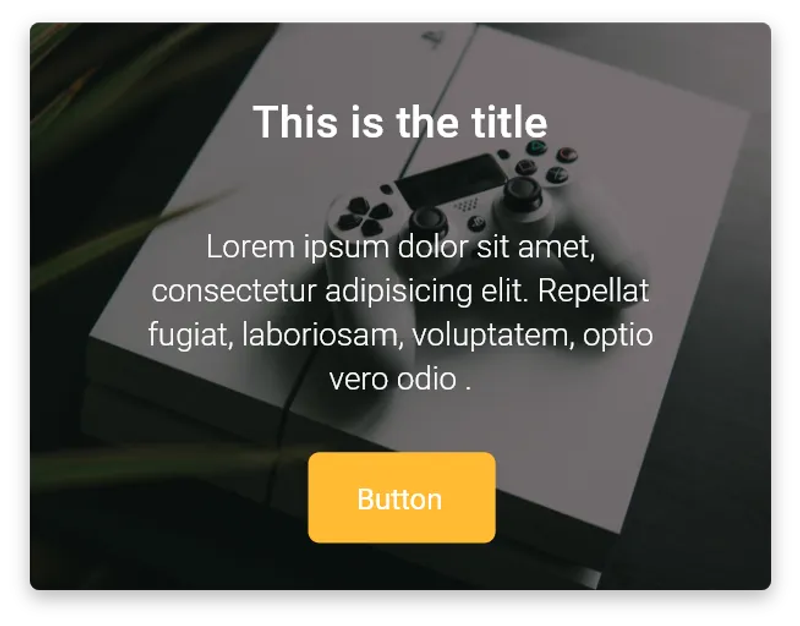| description |
|---|
GF Flutter Card Widget is a customized widget that can use with Image , Avatar , Icon, Button, and ready-to-use custom widget in your app. |
GFCard is a Flutter Card that is used in any section of the application to display certain types of information about the application. It can be simply used with a title and buttons.
A Flutter card typically has a slight border radius and box shadow around it that gives a classic look to the card. It typically has two action buttons, some information and it can even contain images in it.
The simple code of a Flutter card is shown below.
import 'package:getwidget/getwidget.dart';
GFCard(
boxFit: BoxFit.cover,
image: Image.asset('your asset image'),
title: GFListTile(
avatar: GFAvatar(
backgroundImage: AssetImage('your asset image'),
),
title: Text('Card Title'),
subTitle: Text('Card Sub Title'),
),
content: Text("Some quick example text to build on the card"),
buttonBar: GFButtonBar(
children: <Widget>[
GFButton(
onPressed: () {},
text: 'Buy',
),
GFButton(
onPressed: () {},
text: 'Cancel',
),
],
),
),GF Flutter Cards with Flutter Avatar
GFCards can be customized with different other types of GFComponents. GFcards give us data about the particular block. In addition, an avatar gives more precise information about the block. Hence GFAvatar can be used with GFCard to make a GFCard Avatar.
Below is a simple example code of GF Flutter Card with Avatar:
import 'package:getwidget/getwidget.dart';
GFCard(
boxFit: BoxFit.cover,
titlePosition: GFPosition.start,
image: Image.asset(
'lib/assets/cup.jpg',
height: MediaQuery.of(context).size.height * 0.2,
width: MediaQuery.of(context).size.width,
fit: BoxFit.cover,
),
showImage: true,
title: GFListTile(
avatar: GFAvatar(
backgroundImage: AssetImage('your asset image'),
),
titleText: 'Game Controllers',
subTitleText: 'PlayStation 4',
),
content: Text("Some quick example text to build on the card"),
buttonBar: GFButtonBar(
children: <Widget>[
GFAvatar(
backgroundColor: GFColors.PRIMARY,
child: Icon(
Icons.share,
color: Colors.white,
),
),
GFAvatar(
backgroundColor: GFColors.SECONDARY,
child: Icon(
Icons.search,
color: Colors.white,
),
),
GFAvatar(
backgroundColor: GFColors.SUCCESS,
child: Icon(
Icons.phone,
color: Colors.white,
),
),
],
),
),GFCards has OverlayImage property wherein a background image can be placed and upon the image any widget like Text, buttons can be used as shown in the image below.
Below shows a simple example code for GFCard with Card OverlayImage:
import 'package:getwidget/getwidget.dart';
GFCard(
boxFit: BoxFit.cover,
titlePosition: GFPosition.start,
showOverlayImage: true,
imageOverlay: AssetImage(
'your asset image',
),
title: GFListTile(
avatar: GFAvatar(),
titleText: 'Game Controllers',
subTitleText: 'PlayStation 4',
),
content: Text("Some quick example text to build on the card"),
buttonBar: GFButtonBar(
children: <Widget>[
GFAvatar(
backgroundColor: GFColors.PRIMARY,
child: Icon(
Icons.share,
color: Colors.white,
),
),
],
),
),GFCard can be used like GFCard with Avatar, GFCard with ImageOverlay, and just a GFCard. To make the GFcard more flexible with your Flutter card. we have the below custom properties:
| Name | Description |
|---|---|
| titlePosition | helps to set the title at top of the card |
| color | sets the background color of the card |
| elevation | controls the size of the shadow below the card |
| shape | the shape of the card |
| borderOnForeground | whether to paint the shape of the border in front of the child, defaults to true |
| clipBehaviour | defines the clipping of the child |
| margin | defines the card's outer container margin |
| padding | defines the card's outer container padding |
| semanticContainer | represents a single semantic container, if false a collection of semantic nodes |
| border | to draw a border above the card |
| borderRadius | represents the rounded corners of the card |
| colorFilter | applies to the image before painting it |
| boxFit | how the image should be inscribed into the box |
| imageOverlay | display images as background with shaded overlay |
